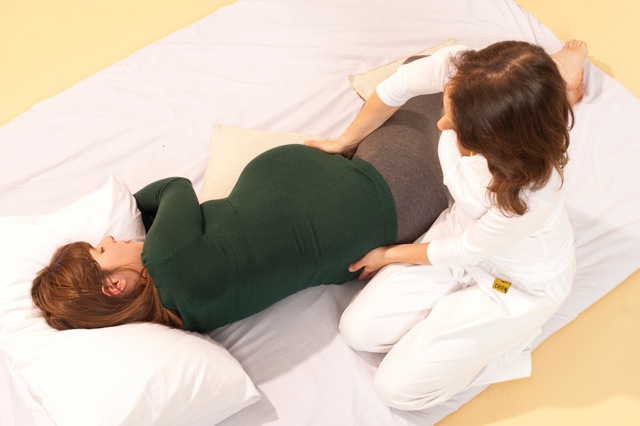
A shiatsu session while you are pregnant can help you establish a deep relationship with your baby early on. Shiatsu re-balances your energy and will support your body in making the changes it needs to during pregnancy.
There are many conditions that arise during pregnancy, which can be helped with Shiatsu. Some of these include: backache, tight shoulders and neck, pelvic discomfort or pains, abdominal compression, ribflair, sciatica, morning sickness, indigestion, oedema, constipation, cramps, restless legs, high blood pressure, breathlessness, anxiety, symphysis pubis pain and many more.
Shiatsu for Fertility, Pregnancy, Post Natal
Shiatsu can be effective in promoting natural fertility as well as supporting the body through assisted conception. It may also help with many of the complaints one might suffer from in pregnancy and post-natally.
Birth Partner Sessions
Shiatsu sessions with partners leading up to the birth can be reassuring for the couple. In labour there are specific focus points and techniques, which may help to induce labour as well as provide pain relief. During the session we work together on how the partner can support the mother and use these points during labour.
Baby Shiatsu
Babies love shiatsu and it can be a wonderful, fun and bonding experience for the family as well as helping heal birth trauma and support during and after periods of illness. Please do feel free to email or call me if you have any questions about it or would like to try a session. It is interactive for the parents and baby (suitable from birth) and gives the parents confidence to continue giving the baby shiatsu at home.
The Baby Shiatsu Course is a 4 week course of one hour classes where we cover three basic treatments and how to support your baby through its first months in life. As a parent you will learn to give simple acupressure massage which will encourage your baby’s health and well-being.
Your baby remains clothed so it is very practical and can be practised anytime, anywhere. Even babies who don’t like massage love Shiatsu because the quality and style of touch is clear and comforting.
What to expect
- How to hold and lift your baby (it might seem obvious, but it’s an important skill to prevent muscle problems later on. Different holding positions can encourage even-sided development and comfort for both mother and baby)
- How to give your baby Shiatsu and support him/her through the natural stages of development over the first few months, this includes:
- Shiatsu on the front of the body – finding my centre, aiding digestion and breathing issues – important for all other stages of development including co-ordinated movement, speech and reading later on.
- Shiatsu on the back of the body to encourage strength in the back and the ability to lift the head and establish an all fours position. Helps posture.
- Shiatsu for the side of the body to encourage rolling and rotational movement. This is important not only for rolling from front to back, but also when the baby begins to move from sitting to standing.
- When to intervene and when not to: We often want to help our babies along in terms of sitting, standing and walking, but sometimes the things we do actually impede their development rather than support it. It’s good to know the difference. We will also learn to recognise when our baby wants touch or not.
- Some points and techniques for common ailments: Things like colic, wind, digestive flow, chest infections etc (depending on what is presenting in the babies in the group)
- Anytime – Anywhere: on your lap, in a pram or on the move. You can do Shiatsu on your baby while you are waiting for a bus!
- Exercises for Mum & Dad – things to do to get back in touch with your own body with some fun exercises and self-massage practices.
Shonishin
Shonishin pediatric acupuncture (sho=little, ni=children, shin=needle)is a specialized form of treatment for infants and children (suitable from birth) that became renowned in the 1700s in the Osaka region of Japan. To this day, Japanese parents regularly bring children for shonishin treatment, and the shonishin approach is increasing in popularity around the world.
Shonishin focuses on gentle, specialized, mostly non-inserted treatment techniques that children find comfortable and even pleasurable. Dramatic results can be obtained even with very light treatment.
Shonishin techniques involve rhythmic stroking, rubbing, tapping, and pressing the skin to give different kinds of gentle stimulation. These techniques harmonize and fortify the child’s vital energy, and strengthen the child’s constitution.
Shonishin can be used to treat a wide variety of problems, including:
- Failure to thrive syndrome
- Weak constitution
- Colic, excessive night crying, temper tantrums
- Indigestion, GERD, constipation, and diarrhea
- Night terrors
- Attention deficit hyperactivity disorder (ADHD)
- Allergies, asthma, and colds
- Eczema and hives
- Ear infections
- Bedwetting
- Stuttering
- Cerebral palsy
- Spina bifida
The specifics of the treatment (frequency, dosage, strength) depend on the practitioner, the age, and condition of the child, among other factors. Treatments for children are actually very brief: a typical treatment generally lasts only one to five minutes. Generally speaking, the older the child, the longer the treatment.
The key to successful Shonishin treatment is “less is better.” The beauty of Shonishin is its simplicity, gentleness, and effectiveness.